
How marriage rates in your state have changed since 1990
How marriage rates in your state have changed since 1990
Data from the Centers for Disease Control and Prevention (CDC) show the national average marriage rate is down from 9.8 marriages per 1,000 people in 1990 to 6.5 per 1,000 in 2018. Over the course of the 20th century, the shifting patterns of marriage behavior in the United States are more stark: Between 1960 and 2010, the percentage of adults who were married went from 72% to 51%. The dramatic shift has created lasting changes in American society and the country's economy.
Between the late 1960s and 1980, the divorce rate doubled, according to the U.S. Census. Over the next several decades, the divorce rate hovered at 50%. Toward the end of the century, people started to delay their first marriage, which the U.S. Census' Current Population Report from the 1990s attributes to a rise in education and work experience among women. Other elements that started shaping marriage trends around this period include more unmarried women having children, thus giving rise to a larger percentage of single-parent families.
So where have marriage rates gone from there? Well, down. The CDC shows that every state has had a decrease in marriage rates from 1990 to 2018; the national average change is -32.5%. Stacker used marriage statistics from the CDC/National Center for Health Statistics to determine how marriage rates in every state have changed since 1990.
Across the board, the nation has seen a decline in marriage rates, due to a variety of contributing factors—the millennial generation delaying marriage (or foregoing it entirely), an aging population, and a rise in education, to name a few. The states are listed here alphabetically, and their changing marriage rates are represented as percent changes from 1990 to 2018 (the most recent year of data available).
According to the CDC, "rates are based on provisional counts of marriage by state of occurrence. Rates are per 1,000 total population residing in the area. Population enumerated as of April 1 for 1990, 2000, and 2010 and estimated as of July 1 for all other years."
Read on to find out how marriage rates in your state have changed since 1990.

Alabama
- Change in marriage rate 1990–2018: -35.8% (#21 biggest decrease among all states)
- 1990 marriage rate: 10.6 per 1,000 people
- 2018 marriage rate: 6.8 per 1,000 people
While marriage rates are declining throughout the country as a whole, Alabama shows a -35.8% change from 1990 to 2018. One of the reasons for this, according to census data, might be the rising median age of residents of Alabama. The current median age is 38.2. As people have delayed marriages across the board, they have had fewer children than in the past, creating a balance shift in older generations to younger ones.

Alaska
- Change in marriage rate 1990–2018: -34.3% (#22 biggest decrease among all states)
- 1990 marriage rate: 10.2 per 1,000 people
- 2018 marriage rate: 6.7 per 1,000 people
Just behind Alabama, Alaska ranks as the 22nd biggest decrease among all states with a -34.3% change. Marriage isn't the only thing on the decline in the state of Alaska either. According to the 2017 Alaska Vital Statistics Report, Alaskan women are having fewer babies, as well. Alaska mothers gave birth to 10,447 babies in 2017. In 2016, 11,216 babies were born.
One of the reasons to explain the decline in marriage and childbirth is the drop in population. According to the Alaska Department of Labor and Workforce Development, this is the second year in a row that there has been a declining total population. As of July 2018, Alaska's population was 736,000, down from 740,000.

Arizona
- Change in marriage rate 1990–2018: -45% (#5 biggest decrease among all states)
- 1990 marriage rate: 10 per 1,000 people
- 2018 marriage rate: 5.5 per 1,000 people
The marriage rate in Arizona is one of the lowest in the country, and has been nearly cut in half since 1990, with just 5.5 marriages per 1,000 people. Arizona also happens to be one of the leaders in the U.S. for divorce. The divorce rate in Arizona is 3 per 1,000.

Arkansas
- Change in marriage rate 1990–2018: -41.8% (#10 biggest decrease among all states)
- 1990 marriage rate: 15.3 per 1,000 people
- 2018 marriage rate: 8.9 per 1,000 people
Arkansas has seen a big decrease in marriage rates over the last few decades, sliding from 15.3 per 1,000 down to 8.9. Arkansas is leading the country in divorces, with 17.14 divorces per 1,000 people, according to the 2017 American Community Survey.

California
- Change in marriage rate 1990–2018: -24.1% (#39 biggest decrease among all states)
- 1990 marriage rate: 7.9 per 1,000 people
- 2018 marriage rate: 6 per 1,000 people
While California didn't have a particularly high marriage rate to begin with, at 7.9 per 1,000 people, it is fast on the way to becoming a state of singles. About half the population of Californians over 18 are currently married, which is down from 74% in 1960. According to the Sacramento Bee, this is because Californians are waiting longer to get married. Another contributing factor is California legalized "no fault" divorce in the 1970s, which doubled the divorce rate. And finally, more and more Californians are cohabitating and raising families outside of marriage.

Colorado
- Change in marriage rate 1990–2018: -22.4% (#43 biggest decrease among all states)
- 1990 marriage rate: 9.8 per 1,000 people
- 2018 marriage rate: 7.6 per 1,000 people
As marriage declines across the U.S., cohabitation is on the rise. Colorado is one of the few states in the country that recognizes Common Law marriage, which is an informal marriage where both parties need only agree that they are married.

Connecticut
- Change in marriage rate 1990–2018: -32.9% (#26 biggest decrease among all states)
- 1990 marriage rate: 7.9 per 1,000 people
- 2018 marriage rate: 5.3 per 1,000 people
Connecticut's marriage rate is slightly below the national average. Data shows that 47.9% of the population was married in 2017. It has some of the lowest marriage rates in the nation. Surrounding states like Massachusetts, New Jersey, and Pennsylvania also have low marriage rates.

Delaware
- Change in marriage rate 1990–2018: -38.1% (#15 biggest decrease among all states)
- 1990 marriage rate: 8.4 per 1,000 people
- 2018 marriage rate: 5.2 per 1,000 people
The marriage rate in the state of Delaware has always been below the national average. In 2018 Delaware was the first state in the nation to ban child marriage. Previously minors in Delaware could marry with parental consent and approval from a judge.

District of Columbia
- Change in marriage rate 1990–2018: -4.9% (#51 biggest decrease among all states)
- 1990 marriage rate: 8.2 per 1,000 people
- 2018 marriage rate: 7.8 per 1,000 people
It seems not much has changed with marriage in Washington D.C. since 1990. With a decrease in marriage rates of just 4.9%, D.C. is the least changed part of the nation. And, with a marriage rate of 7.8 per 1,000, it has one of the highest marriage rates in the country.

Florida
- Change in marriage rate 1990–2018: -33.0% (#24 biggest decrease among all states)
- 1990 marriage rate: 10.9 per 1,000 people
- 2018 marriage rate: 7.3 per 1,000 people
Following the trends of the rest of the nation, more and more people are waiting to get married. The average age for women for a first-time marriage rose from 20 in 1960 to 28 in 2018. Men went from 23 to 30. The longer people wait to get married, the lower the divorce rate, and the lower the rate of remarriages. Median age also greatly affects marriage rates. In 2017 the median age in Florida was 42.
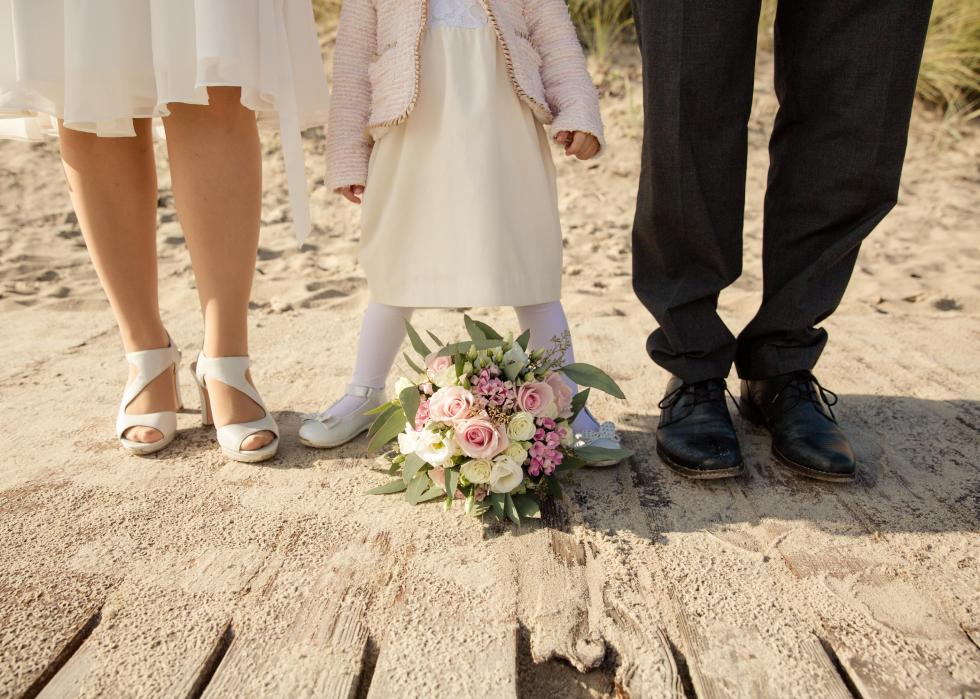
Georgia
- Change in marriage rate 1990–2018: -37.9% (#16 biggest decrease among all states)
- 1990 marriage rate: 10.3 per 1,000 people
- 2018 marriage rate: 6.4 per 1,000 people
The marriage rate in Georgia has dropped significantly since 1990, and is now just under the national average. Georgia also recently signed into law a bill that raises the age of marriage without parental consent from 16 to 17. The new law also prevents 17 year olds from marrying people more than four years their senior.
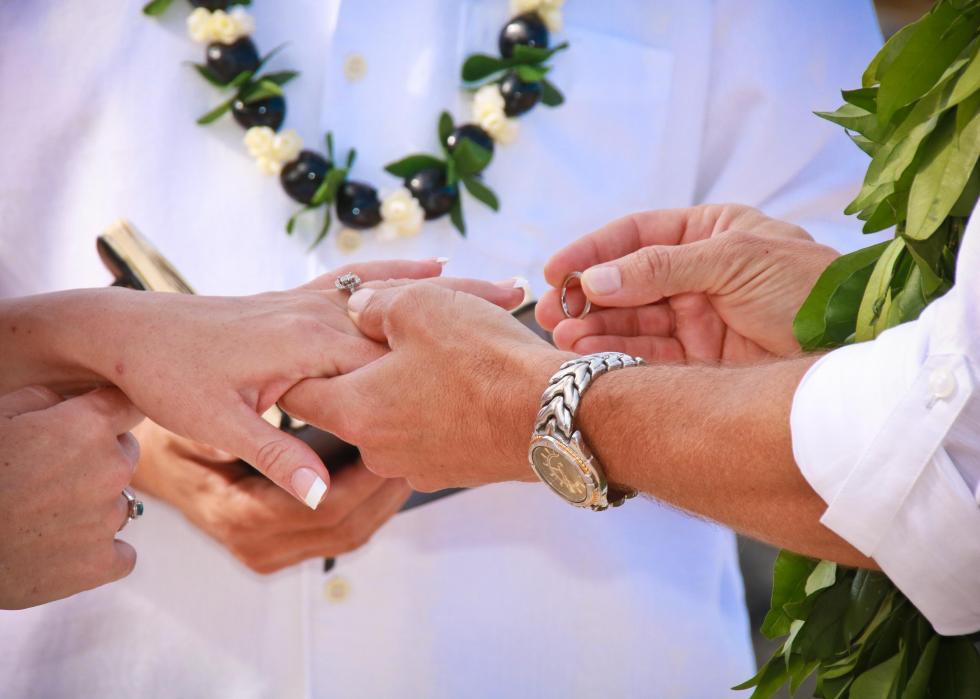
Hawaii
- Change in marriage rate 1990–2018: -6.7% (#50 biggest decrease among all states)
- 1990 marriage rate: 16.4 per 1,000 people
- 2018 marriage rate: 15.3 per 1,000 people
With 15.3 marriages per 1,000 people, Hawaii has one of the highest marriage rates in the country. It also has the second smallest decline in marriage since 1990, with just a 6.7% change. Hawaii legalized gay marriage in 2013. Since then there have been 9,402 same-sex marriages celebrated in the state, according to the Hawaii Department of Health.

Idaho
- Change in marriage rate 1990–2018: -43.9% (#6 biggest decrease among all states)
- 1990 marriage rate: 13.9 per 1,000 people
- 2018 marriage rate: 7.8 per 1,000 people
Idaho's population increased 14% between 2010 and 2019. In 2019 Idaho had an estimated population of 1.7 million. In 2010 it was just over 1.5 million. Because the population increased faster than the marriage rate, the percentage of marriages per capita decreased.

Illinois
- Change in marriage rate 1990–2018: -37.5% (#18 biggest decrease among all states)
- 1990 marriage rate: 8.8 per 1,000 people
- 2018 marriage rate: 5.5 per 1,000 people
Believe it or not, Illinois is the state with the lowest marriage rate in the country, with just 5.5 marriages per thousand people. People in Illinois are getting older, with the median age being 38 years old. Younger people are waiting longer and longer to get married, which also contributes to the plunging marriage rates across the state.
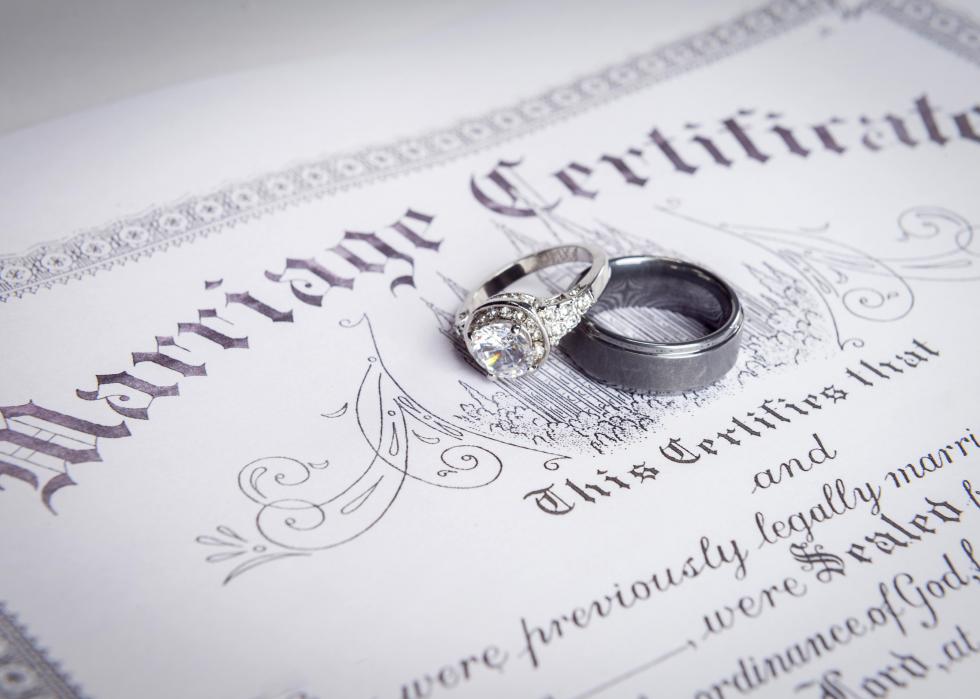
Indiana
- Change in marriage rate 1990-2018: -31.3% (#29 biggest decrease among all states)
- 1990 marriage rate: 9.6 per 1,000 people
- 2018 marriage rate: 6.6 per 1,000 people
Indiana has one of the highest divorce rates in the country with a divorce rate of 11.4% among men and 13.5% among women. Nearly half a million people living in Indiana who are over the age of 15 are divorced. A high divorce rate can affect the way younger people approach their first marriage—from delaying them until later in life or simply cohabitating.
You may also like: 25 ways America has changed in the last decade

Iowa
- Change in marriage rate 1990–2018: -36.7% (#20 biggest decrease among all states)
- 1990 marriage rate: 9 per 1,000 people
- 2018 marriage rate: 5.7 per 1,000 people
Marriage rates in Iowa have plummeted to levels that have not been seen since the 1930s and 1940s. Meanwhile, divorce rates are up. According to the 2018 demographic data from the Department of Public Health, there were 18,085 marriages in 2018, the lowest number since 1944 when there were 17,121 marriages. Again, for Iowans, the reason can be attributed to the millennial rationale of delaying marriage to a more mature and financially stable age.
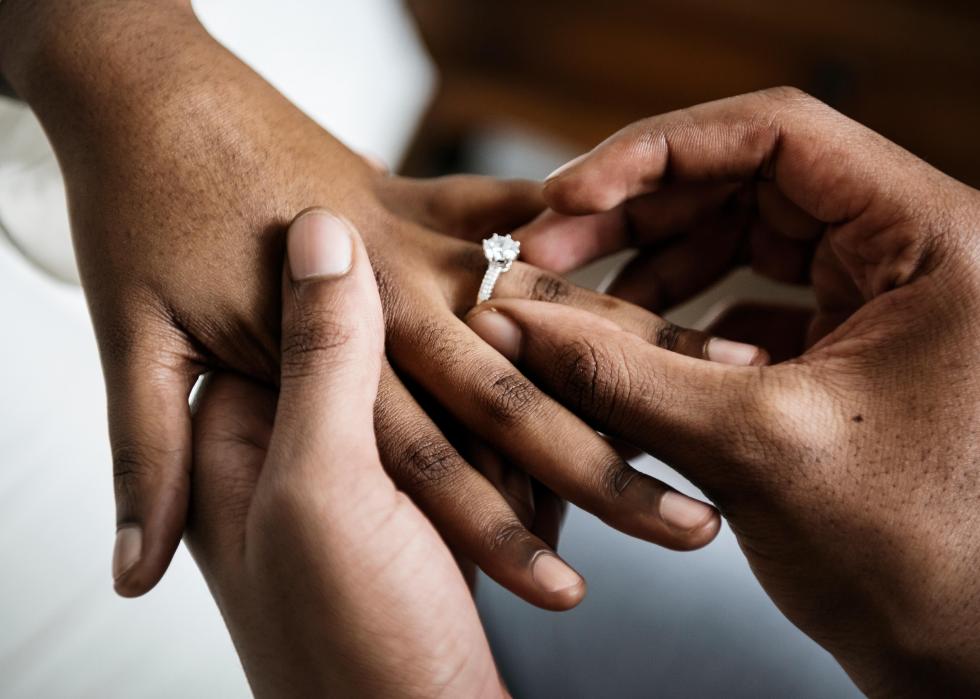
Kansas
- Change in marriage rate 1990–2018: -41.3% (#12 biggest decrease among all states)
- 1990 marriage rate: 9.2 per 1,000 people
- 2018 marriage rate: 5.4 per 1,000 people
If you live in Kansas then you may notice that you're receiving fewer and fewer wedding invites. No, it isn't you. It's a 41.3% decrease in marriage rates. In 1990 Kansas had 9.2 marriages per 1,000 people. Today the marriage rate is 5.4, which is below the national average. Subsequently, the divorce rate in Kansas is at an all-time low, as well. Back in the day, it was common for people to marry in their late teens and early 20s in Kansas. Today that is less and less common, and many couples are opting to skip marriage entirely.

Kentucky
- Change in marriage rate 1990–2018: -49.6% (#3 biggest decrease among all states)
- 1990 marriage rate: 13.5 per 1,000 people
- 2018 marriage rate: 6.8 per 1,000 people
With one of the biggest decreases in marriage rates in the country, Kentucky went from a state with 13.5 marriages per 1,000 in 1990, to just 6.8 per 1,000 in 2018. The Kentucky Marriage Movement attributes this to the rise of cohabitation. Kentucky is also one of the states with the highest numbers of child marriages per year, though that number is on the steady decline.
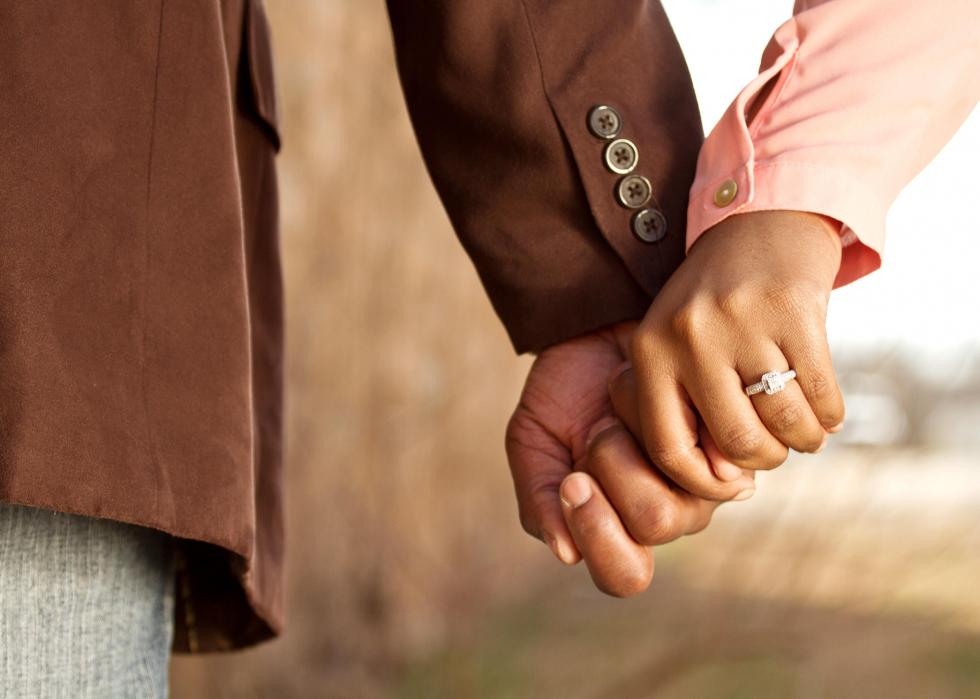
Louisiana
- Change in marriage rate 1990–2018: -46.9% (#4 biggest decrease among all states)
- 1990 marriage rate: 9.6 per 1,000 people
- 2018 marriage rate: 5.1 per 1,000 people
Louisiana's marriage rate has dropped a whopping 46.9% since 1990. Today the marriage rate is much lower than the national average, with 5.1 per 1,000. In 2019 Louisiana passed a new law establishing a minimum age for marriage in the state. Previously there was none. Now a person must be at least 16 years old to marry in Louisiana.

Maine
- Change in marriage rate 1990–2018: -23.7% (#41 biggest decrease among all states)
- 1990 marriage rate: 9.7 per 1,000 people
- 2018 marriage rate: 7.4 per 1,000 people
The pine tree state's marriage rate dipped like the rest of the nation's, yet it still retains a marriage rate higher than the national average with 7.4 per 1,000 people. Maine's divorce rate has also dropped lower than it has been in years with 3.2 divorces per 1,000.

Maryland
- Change in marriage rate 1990–2018: -39.2% (#14 biggest decrease among all states)
- 1990 marriage rate: 9.7 per 1,000 people
- 2018 marriage rate: 5.9 per 1,000 people
The marriage rate in Maryland has been chopped by nearly 40% since 1990, from 9.7 per 1,000 people to 5.9. Maryland is dealing with the controversial topic of minimum marriage age. In 2019 the bill to raise the minimum age was rejected for the fourth year in a row. Under state law, minors that are 15 can marry in the case of pregnancy or birth of a child, with parental consent. Those who are 16 and 17 need only parental consent.

Massachusetts
- Change in marriage rate 1990–2018: -20.3% (#45 biggest decrease among all states)
- 1990 marriage rate: 7.9 per 1,000 people
- 2018 marriage rate: 6.3 per 1,000 people
Massachusetts' marriage rates have dropped since 1990, but the numbers are among the least memorable compared to other states. In 1990 the marriage rate was 7.9 per 1,000. Today it is 6.3, below the national average. In 2004 Massachusetts became the first U.S. state to legalize gay marriage. More than 22,000 same-sex marriages were performed in Massachusetts between 2004 and 2012.

Michigan
- Change in marriage rate 1990–2018: -30.5% (#31 biggest decrease among all states)
- 1990 marriage rate: 8.2 per 1,000 people
- 2018 marriage rate: 5.7 per 1,000 people
Michigan's marriage rate sits at 5.7 per 1,000 people, which is a 30.5% decrease from 1990 when it was 8.2 per 1,000. According to the Michigan Department of Health and Human Services, Michigan's birth rate hit a record low in 2018, which is a trend related to delaying marriage and children.

Minnesota
- Change in marriage rate 1990–2018: -31.2% (#30 biggest decrease among all states)
- 1990 marriage rate: 7.7 per 1,000 people
- 2018 marriage rate: 5.3 per 1,000 people
The marriage rate in Minnesota has dropped 31.2% since 1990. Historically, Minnesota has had a marriage rate that is consistently lower than the national average. In 1990 the national average was about 9.8, while in Minnesota it was 7.7.
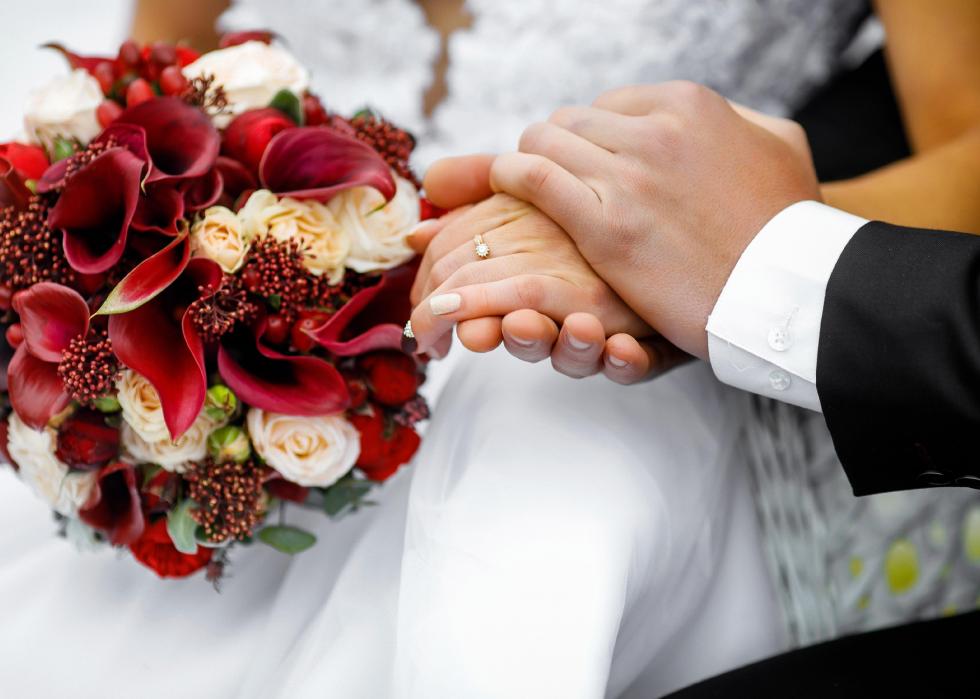
Mississippi
- Change in marriage rate 1990–2018: -33% (#25 biggest decrease among all states)
- 1990 marriage rate: 9.4 per 1,000 people
- 2018 marriage rate: 6.3 per 1,000 people
Mississippi has seen a flat 33% decrease in the marriage rate since 1990. Today the marriage rate is 6.3 per 1,000. Mississippi is the only state in the country to have the minimum age of marriage set at 21 without parental consent. Women ages 15–21 and males 17–21 can marry with parental consent. That said, minors who are under the minimum age may still marry with parental consent plus the approval of the court.

Missouri
- Change in marriage rate 1990–2018: -32.3% (#27 biggest decrease among all states)
- 1990 marriage rate: 9.6 per 1,000 people
- 2018 marriage rate: 6.5 per 1,000 people
Missouri's marriage rate decreased 32.3%. That said, the marriage rate in 2018 was still higher than the national average, if only slightly. As of 2018, the CDC reported that Missouri has a divorce rate of 3.1 divorces per 1,000 people.

Montana
- Change in marriage rate 1990–2018: -10.5% (#49 biggest decrease among all states)
- 1990 marriage rate: 8.6 per 1,000 people
- 2018 marriage rate: 7.7 per 1,000 people
Montana is one of those states where people are still clinging to “till death do us part.” The state saw only a 10.5% decrease in marriage rates, and is still above the national average at 7.7 per 1,000 people. According to World Population Review, just over half the population of Montana is married.

Nebraska
- Change in marriage rate 1990–2018: -25% (#37 biggest decrease among all states)
- 1990 marriage rate: 8 per 1,000 people
- 2018 marriage rate: 6 per 1,000 people
Nebraska's marriage rate has only dropped by 25% in the last nearly 30 years, and has been on a steady decline since the 1970s. Its rates rose dramatically during the 1960s, but that has not been the case since.

Nevada
- Change in marriage rate 1990–2018: -73% (#1 biggest decrease among all states)
- 1990 marriage rate: 99 per 1,000 people
- 2018 marriage rate: 26.7 per 1,000 people
Nevada has always been a state with a high marriage rate, but even a state with such a robust marriage profile has fallen. In fact, because the marriage rate was so high (99 per 1,000 people), it had the furthest to fall. So while Nevada's marriage rate is still the highest in the country at 26.7 per 1,000, the rate has dropped 73% since 1990. Historically Nevada has always been a convenient place to get married, seeing as there is no waiting period between the ceremony and issuing a marriage license. That said, there are far more marriage licenses issued in Nevada than actually married couples because many people who get married in Nevada are from somewhere else.
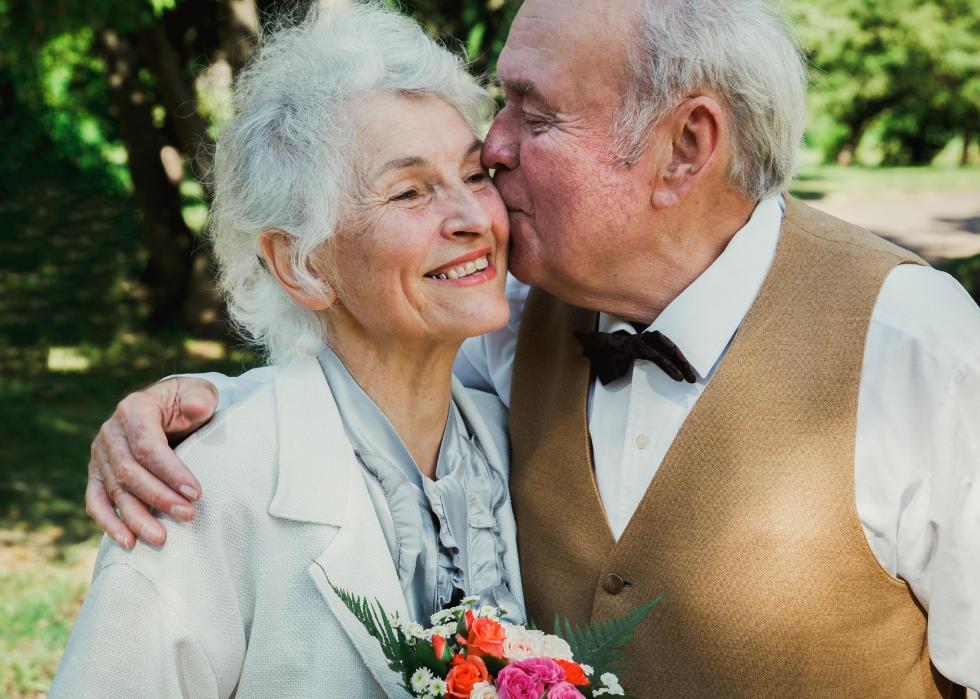
New Hampshire
- Change in marriage rate 1990–2018: -27.4% (#35 biggest decrease among all states)
- 1990 marriage rate: 9.5 per 1,000 people
- 2018 marriage rate: 6.9 per 1,000 people
New Hampshire's marriage rate is still above the national average, but with a median age of 42.4 years, as well as one of the slowest population increases in the country, it's not surprising that the marriage rate has slowed down.

New Jersey
- Change in marriage rate 1990–2018: -28.9% (#33 biggest decrease among all states)
- 1990 marriage rate: 7.6 per 1,000 people
- 2018 marriage rate: 5.4 per 1,000 people
New Jersey's marriage rates have fallen below the national average since 1990. Today the marriage rate of New Jersey is 5.4 per 1,000 people. New Jersey has one of the highest concentrations of millennials in the country. In 2016 millennials made up 30% of New Jersey's population.

New Mexico
- Change in marriage rate 1990–2018: -27.3% (#36 biggest decrease among all states)
- 1990 marriage rate: 8.8 per 1,000 people
- 2018 marriage rate: 6.4 per 1,000 people
The marriage rate in New Mexico is slightly just about on par with the national average, with 6.4 marriages per 1,000. This is down by 27.3% from 1990. New Mexico has had a stagnant population growth for the past few years. The Census Bureau estimates that the population of New Mexico grows less than 1% annually.

New York
- Change in marriage rate 1990–2018: -17.4% (#47 biggest decrease among all states)
- 1990 marriage rate: 8.6 per 1,000 people
- 2018 marriage rate: 7.1 per 1,000 people
New York State's marriage rate is still higher than the national average, with 7.1 marriages per 1,000, but marriage overall has still declined since 1990. New York State is one of the only states to be experiencing consecutive annual decreases in population. According to the Empire Center for Public Policy, the state of New York saw a 0.4% decline in 2019 over the previous year.

North Carolina
- Change in marriage rate 1990–2018: -17.9% (#46 biggest decrease among all states)
- 1990 marriage rate: 7.8 per 1,000 people
- 2018 marriage rate: 6.4 per 1,000 people
As of 2019, 4 million people in North Carolina over the age of 15 are married. According to Carolina Demography, the average age of North Carolina's married residents is 51.6, while the never-married residents were, on average, much younger at 29.3. More than half the population of North Carolina is unmarried.

North Dakota
- Change in marriage rate 1990–2018: -24.0% (#40 biggest decrease among all states)
- 1990 marriage rate: 7.5 per 1,000 people
- 2018 marriage rate: 5.7 per 1,000 people
North Dakota's decline in marriage since 1990 has been 24%, though the marriage rate in the state has always been below the national average. The population of North Dakota is less than 1 million people total.

Ohio
- Change in marriage rate 1990–2018: -37.8% (#17 biggest decrease among all states)
- 1990 marriage rate: 9 per 1,000 people
- 2018 marriage rate: 5.6 per 1,000 people
Ohio's marriage rate fell by nearly 40% (37.8) between 1990 and 2018. Today the marriage rate is 5.6 per 1,000 people. Divorce is also very high in Ohio. According to the 2014–2018 Community Survey, the overall divorce rate is 9% in the state. There are more than 800,000 people living in Ohio who are divorced, out of 11.6 million residents.

Oklahoma
- Change in marriage rate 1990–2018: -39.6% (#13 biggest decrease among all states)
- 1990 marriage rate: 10.6 per 1,000 people
- 2018 marriage rate: 6.4 per 1,000 people
Like the rest of the Midwest, Oklahoma's marriage rates have also been on the decline since 1990. In 2018 there were 6.4 marriages per 1,000. But Oklahoma also has one of the highest percentages of teen marriages in the country. According to Pew Research, there were 5.8 teen marriages per 1,000 in Oklahoma in 2014.

Oregon
- Change in marriage rate 1990–2018: -29.2% (#32 biggest decrease among all states)
- 1990 marriage rate: 8.9 per 1,000 people
- 2018 marriage rate: 6.3 per 1,000 people
Oregon's marriage rate is like the rest of the nation: on the decline. In 1990 marriage in Oregon was 8.9 per 1,000. As of 2018 it has dropped 29.2% to 6.3. Oregon, and the Pacific Northwest in general, has one of the largest concentrations of millennials in the country. Millennials account for about a fifth of the greater Portland Area.

Pennsylvania
- Change in marriage rate 1990–2018: -22.5% (#42 biggest decrease among all states)
- 1990 marriage rate: 7.1 per 1,000 people
- 2018 marriage rate: 5.5 per 1,000 people
Pennsylvania's decline in marriage (7.1 to 5.5) can partially be attributed to an aging population. According to the Pennsylvania State Data Center, the ages of Pennsylvania citizens skews older than the rest of the nation. It has 2.2 million people over 65 and the median age is 40.8

Rhode Island
- Change in marriage rate 1990–2018: -22.2% (#44 biggest decrease among all states)
- 1990 marriage rate: 8.1 per 1,000 people
- 2018 marriage rate: 6.3 per 1,000 people
Rhode Island has one of the oldest populations in the country. In 2016 the median age of residents was 40. Still, Rhode Island has been on a campaign to get millennials to #ChooseRI. The plan may be working, however slowly. The most recent data shows that the median age in Rhode Island is now 38.

South Carolina
- Change in marriage rate 1990–2018: -58.5% (#2 biggest decrease among all states)
- 1990 marriage rate: 15.9 per 1,000 people
- 2018 marriage rate: 6.6 per 1,000 people
South Carolina has one of the biggest declining marriage rates in the country. From 1990 until 2018 marriage rates plummeted by 58.5%. As the percentage of married-couple families has decreased, families headed by a single adult have been on the rise. South Carolina increased female single-headed households by 130%, while single-male headed households have gone up by 230%.
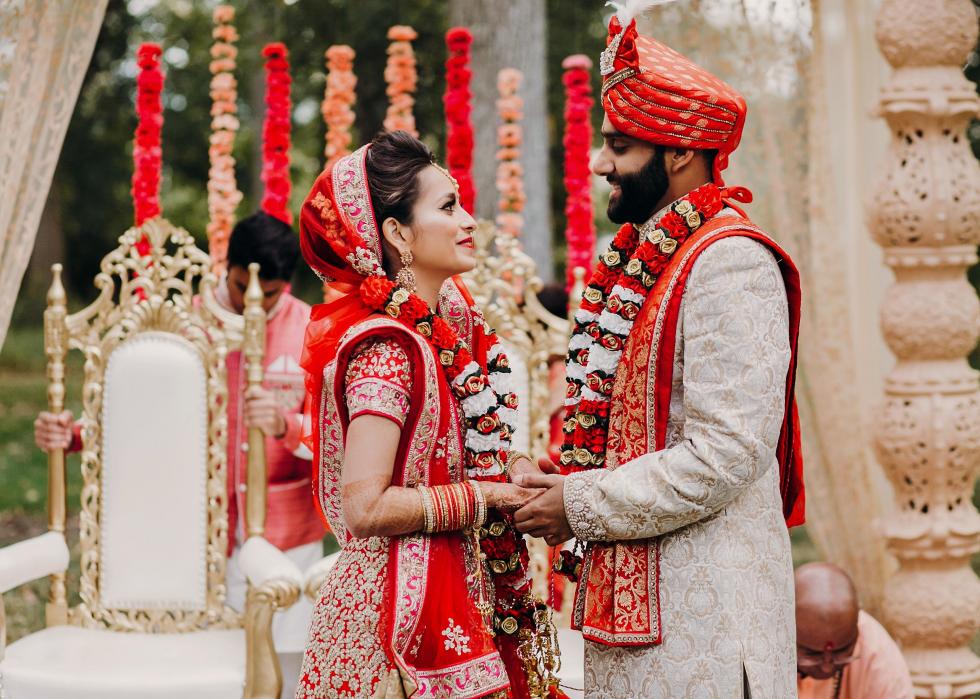
South Dakota
- Change in marriage rate 1990–2018: -41.4% (#11 biggest decrease among all states)
- 1990 marriage rate: 11.1 per 1,000 people
- 2018 marriage rate: 6.5 per 1,000 people
South Dakota's marriage rate is going down, likely because of an aging population. According to the U.S. Census Bureau, the South Dakota population is continuing to age. The fraction of the population more than 65 years old has grown to 16.3% in 2017.

Tennessee
- Change in marriage rate 1990–2018: -42.4% (#8 biggest decrease among all states)
- 1990 marriage rate: 13.9 per 1,000 people
- 2018 marriage rate: 8 per 1,000 people
While marriage rates have declined in Tennessee by 42.4%, the state is still clinging to an outdated mindset when it comes to “traditional” marriage. A controversial bill has been drawn up that would ignore the U.S. Supreme Court's 2015 ruling legalizing same-sex marriage. If passed, the Tennessee Natural Marriage Defense Act could cost the state $9.4 billion in federal funds.

Texas
- Change in marriage rate 1990–2018: -41.9% (#9 biggest decrease among all states)
- 1990 marriage rate: 10.5 per 1,000 people
- 2018 marriage rate: 6.1 per 1,000 people
Marriage in Texas is consistent with the rest of the country, as well. It is down by 41.9%. Interestingly, the millennial population has been on the rise in Texas since 2010. The millennial population of Texas rose by 10% from 2010 to 2015, which is nearly twice the national growth rate.

Utah
- Change in marriage rate 1990–2018: -25% (#38 biggest decrease among all states)
- 1990 marriage rate: 11.2 per 1,000 people
- 2018 marriage rate: 8.4 per 1,000 people
Utah used to have one of the highest marriage rates in the country, with 11.2 marriages per 1,000 in 1990. But marriage rates have dropped by 25% since then, and according to Utah's Public Health Data Resource, it's still on the decline. There was a spike in 2015 with a rate of 8.1 and then in 2016 with a rate of 9, but has been on a decline since.

Vermont
- Change in marriage rate 1990–2018: -27.5% (#34 biggest decrease among all states)
- 1990 marriage rate: 10.9 per 1,000 people
- 2018 marriage rate: 7.9 per 1,000 people
Vermont experienced a 27.5% downward change in marriage, but the marriage rate in the state is still higher than the national average at 7.9. The median age across the population of Vermont is high, at 42.6 years. Vermont has one of the lowest divorce rates in the country, as well, at 2.9 per 1,000.

Virginia
- Change in marriage rate 1990–2018: -43.9% (#7 biggest decrease among all states)
- 1990 marriage rate: 11.4 per 1,000 people
- 2018 marriage rate: 6.4 per 1,000 people
Virginia's marriage rates are showing some of the biggest decreases in the country, at 43.9%. The 1990 marriage rate was 11.4 per 1,000. Today it is 6.4 per 1,000. Until late last year, couples in Virginia were required to disclose their race in order to get a marriage license. In some cases, couples were denied. Three couples filed a federal lawsuit and the changes now no longer force Virginians to disclose.
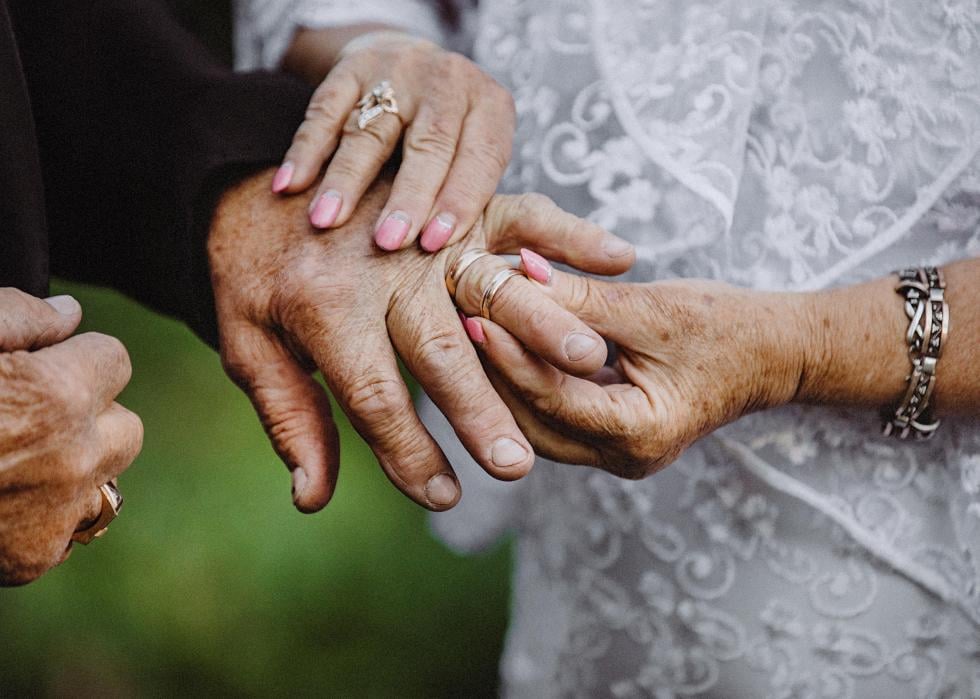
Washington
- Change in marriage rate 1990-2018: -36.8% (#19 biggest decrease among all states)
- 1990 marriage rate: 9.5 per 1,000 people
- 2018 marriage rate: 6 per 1,000 people
Since 1990 marriage in Washington has gone down 36.8%. Research has attributed the national decline in marriage across the country to rising rates in education, and in Washington state, more than 90% of the population 25 years and older is a high school graduate or higher.

West Virginia
- Change in marriage rate 1990–2018: -15.3% (#48 biggest decrease among all states)
- 1990 marriage rate: 7.2 per 1,000 people
- 2018 marriage rate: 6.1 per 1,000 people
West Virginia is one of the least-changed states when it comes to marriage. In 1990 there were 7.2 marriages per 1,000. Today there are 6.1 marriages per 1,000, showing only a 15.3% decrease. From 2010 to 2018, only nine counties in West Virginia experienced population growth.
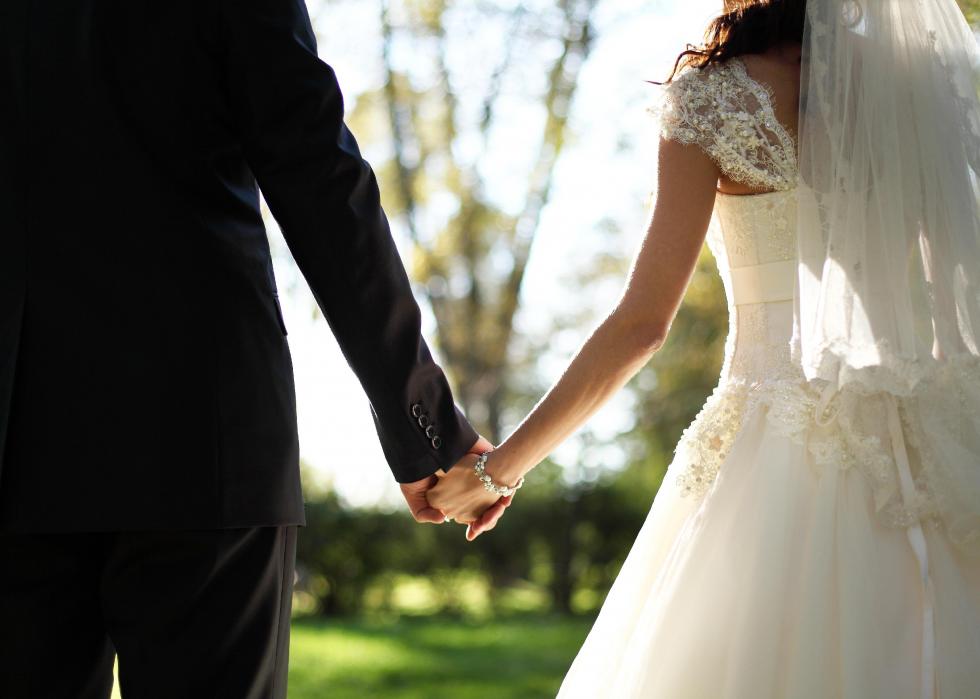
Wisconsin
- Change in marriage rate 1990–2018: -31.6% (#28 biggest decrease among all states)
- 1990 marriage rate: 7.9 per 1,000 people
- 2018 marriage rate: 5.4 per 1,000 people
Marriage rates in Wisconsin have always been below the national average. In 2018 marriage rates were 5.4 per 1,000. Residents of Wisconsin have been putting off marriage until later in life. In 1960 the median age at first marriage was 21.6. In 2015 it was 27.6.

Wyoming
- Change in marriage rate 1990–2018: -33.6% (#23 biggest decrease among all states)
- 1990 marriage rate: 10.7 per 1,000 people
- 2018 marriage rate: 7.1 per 1,000 people
Wyoming has experienced a 33.6% decline in marriage rates since 1990. Though the marriage rate is still above the national average, marriage overall is on the decline. One of the reasons for this could be the excessive shrinking population in the state. A shrinking coal mining industry is forcing people out of the state in record numbers. Wyoming is the fastest-shrinking state in the country.



